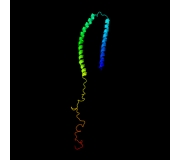HUMAN SNCA, ALPHA-SYNUCLEIN 3-135pg/ml Assay Range HIGH SENSITIVITY ELISA KIT (α-Synuclein, Alpha Synuclein, SNCA; Human; Part No. hSNCA-ELISA 96T)
 Click to enlarge |
|
|
Human Alpha-Synuclein (α-synuclein, SNCA) High Sensitivity ELISA Assay Kit I (96T)
Email customersupport@fivephoton.com for current lead time estimate.
Assay range: 3 - 135 pg/ml. Sensitivity: 1.5 pg/ml. Standard peptide concentration: 135 pg/ml
Fully guaranteed to meet specifications
Human Alpha-Synuclein ELISA Kit
Part No. hSNCA-ELISA for human alpha-synuclein. (Separate alpha-synuclein ELISA kits are also available for mouse, rat and rabbit; please inquire about other species)
Lead Time: Approximately 2 weeks.
Methods Overview
The included ELISA 96-well micro-strip plate is provided pre-coated with an affinity purified rabbit polyclonal capture antibody selective to the antigen. Upon addition of samples to the wells, the antigen in solution binds to the antibody and becomes indirectly linked to the solid support. After washes of unbound materials, a second affinity purified polyclonal antibody conjugated with horse-radish peroxidase (HRP) is added, followed by a second incubation period. Unbound antibody is washed, and then color reagents are added, which upon conversion by HRP, become blue colored. A stop solution is added to block further reaction between HRP and the colorimetric substrates, converting the solution into a yellow coloration. An absorbance multiplate reader is used to quantitate the colorimetric reaction at 450 nm.
This ELISA assay kit provides a standard peptide solution with known concentration to calibrate absorbance readings to concentration.
Image: NMR structure of human alpha-synuclein. Source PDB: DOI:10.2210/pdb1xq8/pdb
Representative Sandwich ELISA Methods to Alpha-Synuclein (SNCA) 
Steps of Sandwich α-Synuclein ELISA
1. Equilibrate plate to ambient temperature
2. Add sample, incubate 30 min - 1hr, wash
3. Add HRP-Antibody, incubate 30 min - 1 hr, wash
4. Add the color reagent, incubate 15 min
5. Add the stop solution
Background: Alpha-Synuclein: Alpha-synuclein (SNCA gene) is a 140 amino acid protein expressed in brain that is associated with fibrillar structures in Lewy Bodies. Although primary located in the cytosol, alpha-synuclein binds to phospholipid and may assemble into pore-like structures in cellular membranes. Generation of aggregates in Lewy Bodies and/or association of mutant or wild-type alpha-synuclein with membraneous structures have been attributed to the etiology of both early-onset congenital and age-related Parkinson’s Disease.
Parkinson's disease is a complex neurodegenerative disorder characterized by bradykinesia, resting tremor, muscular rigidity and postural instability. Additional features of the disease include the characteristic postural abnormalities, dysautonomia, dystonic cramps, and dementia. The pathology of Parkinson disease involves the loss of dopaminergic neurons in the substantia nigra and the presence of Lewy bodies in brain and spinal cord.
Alternate ELISA kits to alpha-synuclien are available.
Kit 1: Assay range for human alpha-synuclein: 160pg/ml - 10ng/ml Please view this link: click here
Kit 2: Please view this link: click here
References on Alpha-Synuclein
For research only. Not for diagnostics.
Safety: Stop solution contains acid. Avoid ingestion, skin and eye contact.
Storage: 4oC.
Shipping. Overnight domestic delivery recommended with ice pack (cost: $52 for 1-2 kits). Also avaialble for international delivery; please inquire for shipping cost.
Related Research Tool. Fluorescent Dopamine (Part DnsylD-1). Dopamine conjugated with the fluorescent tag dansyl through a 5-carbon polylinker. This fluorescent compoud manufactured exclusively by Fivephoton Biochemicals maintains the biochemical and pharmacological characteristics of native dopamine allowing effective application in transporter and ligand binding assays as a fluorescent tracer. The dansyl fluorescent tag produces a bright blue fluorescence with a large stokes shift between Ex and Em, which minimizes autofluorescence and non-specific signal. Link to product: click here
|
 Products
Products Manuals
Manuals








